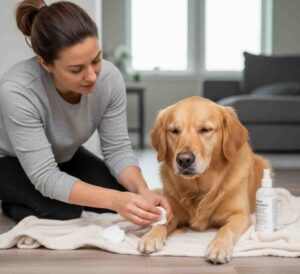The sound has become familiar—that persistent scratching in the middle of the night, the constant licking of paws, the frustrated shaking of ears. When your pet seems uncomfortable in their own skin, it’s hard not to feel helpless. Skin conditions are among the most common reasons pets visit veterinarians, and understanding what might be bothering your companion is the first step toward relief.
Reading the Signs: What Your Pet’s Skin is Telling You
Healthy pet skin should be clean, smooth, and free of irritation. When problems develop, they communicate through various visible signals:
Common Skin Issue Indicators:
-
Excessive scratching, licking, or chewing at particular areas
-
Redness or inflammation on the skin surface
-
Flaky skin or excessive dandruff
-
Bald patches or thinning fur
-
Sores, scabs, or hot spots (moist, inflamed areas)
-
Unusual odors coming from the skin
-
Shaking head or scratching ears frequently
These symptoms often cluster together, and their location can provide important clues about the underlying cause.
Frequent Causes of Skin Discomfort
Environmental Allergies
Much like humans, pets can develop sensitivities to environmental triggers. These often include pollen from grasses, trees, and weeds, as well as mold spores and dust mites. Unlike humans who typically react with respiratory symptoms, pets usually respond with skin problems. You might notice seasonal patterns to their discomfort, or specific locations where symptoms are most pronounced—often the paws, ears, and underside.
Food Sensitivities
While less common than environmental allergies, food reactions can cause significant skin issues. Contrary to popular belief, grains are rarely the primary culprit. Most food-related skin problems stem from animal proteins like chicken, beef, or dairy. These sensitivities typically cause year-round symptoms rather than seasonal patterns, and may involve both skin and digestive issues.
Parasitic Problems
External parasites remain a frequent source of skin irritation. Fleas can trigger intense itching, particularly in sensitive animals who may react to just a single bite. Other microscopic mites can cause conditions like mange, which often presents with hair loss and severe itching. Regular preventive measures are important, but sometimes these tiny invaders still cause problems.
Skin Infections
When the skin’s natural defenses are compromised, bacterial or fungal infections can take hold. These often develop secondary to other issues like allergies or parasites. Infections typically feature more pronounced redness, pustules, crusting, and sometimes an unpleasant odor. They rarely resolve without appropriate treatment.

Gentle Home Care Approaches
Soothing Baths:
Using a gentle, skin-friendly cleanser with warm (not hot) water can help remove allergens and soothe irritation. Limit bathing to once every week or two unless directed otherwise by your veterinarian, as over-bathing can strip natural oils.
Paw Care:
Wiping your pet’s paws after outdoor exposure can significantly reduce the amount of environmental allergens they track inside. Use a damp cloth and pay special attention to between the toes.
Environmental Management:
Regular washing of pet bedding in hot water helps reduce allergen buildup. Using a high-quality air filtration system can also minimize airborne irritants in your home.
Dietary Considerations:
If you suspect a food sensitivity, consult your veterinarian about conducting a proper elimination diet. This systematic approach is more reliable than random food switching and provides clearer answers.
When Home Care Isn’t Enough: Recognizing Warning Signs
While mild irritation might respond to conservative management, certain symptoms warrant professional attention. Contact your veterinarian if you observe:
-
Intense scratching that interrupts sleep or normal activities
-
Signs of pain when touched or moving
-
Open wounds, bleeding, or oozing lesions
-
Widespread hair loss beyond normal shedding
-
Lethargy, loss of appetite, or other systemic symptoms
-
No improvement after several days of home care
Working With Your Veterinarian
When home approaches aren’t providing sufficient relief, your veterinarian can help identify the underlying cause. They might recommend:
Diagnostic Testing to identify specific allergies through skin or blood tests, or to detect parasites through skin scrapings and examinations.
Medicated Treatments including anti-itch medications, antibiotics for infections, or specialized shampoos for particular conditions.
Allergy Management Plans that may include immunotherapy (allergy shots or drops) for long-term relief from environmental allergies.
The Path to Comfort
Successfully managing skin conditions often requires patience and persistence. What works for one animal might not work for another, and finding the right approach can take time. The goal is not necessarily complete elimination of symptoms, but achieving a comfortable quality of life where itching doesn’t dominate your pet’s days and nights.
By learning to recognize the signs of skin discomfort, implementing gentle home care strategies, and knowing when to seek professional help, you’re taking important steps toward helping your pet feel comfortable in their own skin again. Their relief will be visible in their peaceful rest, their playful energy, and the simple joy of seeing them live without constant irritation.



